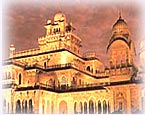Amber Fort built in 16th century by Maharaja Man Singh,it sprawls on the hillside. Its construction was started by Raja Man Singh but completed by his descendant Jai Singh. Amber is the classic romantic Rajasthan fort palace. Amber today is nothing but a reflection of the glorious past of the fierce Kachwaha Dynasty that ruled over this region from 12th to 18th century. the Amber fort is built in re sandstone and white marble; the palace complex has very interesting apartments. the old township of Amber lies at the foothills of the palace and has an old world charm. The rugged walls of this fort may not look beautiful from outside, but the interior is a virtual paradise and painted scenes of hunting and wars adorn the walls along with precious stones and mirrors set into the plaster.
City Palace
City Palace known as core of the Rajasthan, which is situated in the heart of the city. The Palace is now converted in a museum except for a one section where the erstwhile royal family still lives. The Palace cum museum is constructed in the fortified campus style and covers more than half of the old city. There are different sections of the museum dedicate to subjects like arms and ammunition, textile and costume, and art gallery.
Hawa Mahal
Hawa Mahal is located in the Tripolia Bazaar in the west of GPO. This most famous landmark of Jaipur is not actually a palace but a series of sandstone screens. This pink structure was constructed so that the ladies of the palace could watch the royal processions without being seen by any outsider. This sandstone was named Palace of winds after the many brass wind vanes that adorned it until 1960s
Jantar Mantar
Jantar Mantar was built by Sawai Jai Singh. He was a great admirer of progress and research made in the fields of science and technology, but he was passionate about astronomy. Jantar Mantar is a grand celebration of astronomical science and each instrument here serves a particular function and gives an accurate reading.
Ram Bagh Palace
Ram Bagh Palace is now one of the leading heritage hotels in India, run by indian hotels Taj Groups of Hotels. The Palace has wide terraces, spacious corridors and banquet rooms give the impressions of imperial legacy that the palace has come to unique. The queen of Jaipur constructed it in 1835. Later on the need as a guest house an dhunting lodge came, it was changed accordingly.
Sisodia Rani Ka Bagh
The garden of Sisodia queen is situated on the Jaipur Agra Road at a distance of 10km from Jaipur. The garden was created by the queen of Jai Singh II as an escape from the court intrigues. the landscape gardens and murals of the life of the Lord Krishna, decorating its interiors, are breathtakingly beautiful.
Birla Mandir / Laxmi Narayan Mandir
The Birla Mandir situated in the south of Jaipur has been built by wealthy Birla family.One of the largest industrial dynasties in India. This white marble has three domes, each styled according to different approaches to religion.
Jaigarh Fort
Jaigarh fort is a rugged structure built in 1726 by Sawai Jai Singh situated in the north of Jaipur. Its structure is quite similar to Amber Fort. The only exception is that it houses the mighty Jaivana, the largest wheeled canon in the world. Other attractions in the Jaigarh Fort include three water tanks, a museum, and breathtaking views of the city below
Central Museum
Situated in the midst of Ramniwas Gardens, it is an imposing stone structure executed in the Indo-Persian style of architecture. the museum has a wide range of metal objects used for domestic purpose. Earlier known as Albert Hall, this building was built to welcome Prince of Welcome during his visit to India in 1853.
Maharaja Sawai Man Singh II Museum
This museum is situated in the Chandra Mahal Palace, built by Maharaja Sawai Man Singh, when he constructed his new capital at Jaipur in 1727. The museum dispalys the ancestral collections of former Maharajas, paintings , maps, carpets, textiles costumes, and weapons and decorative art objectsdepicting courtly life in jaipur state between the 16th and 19th century. |









